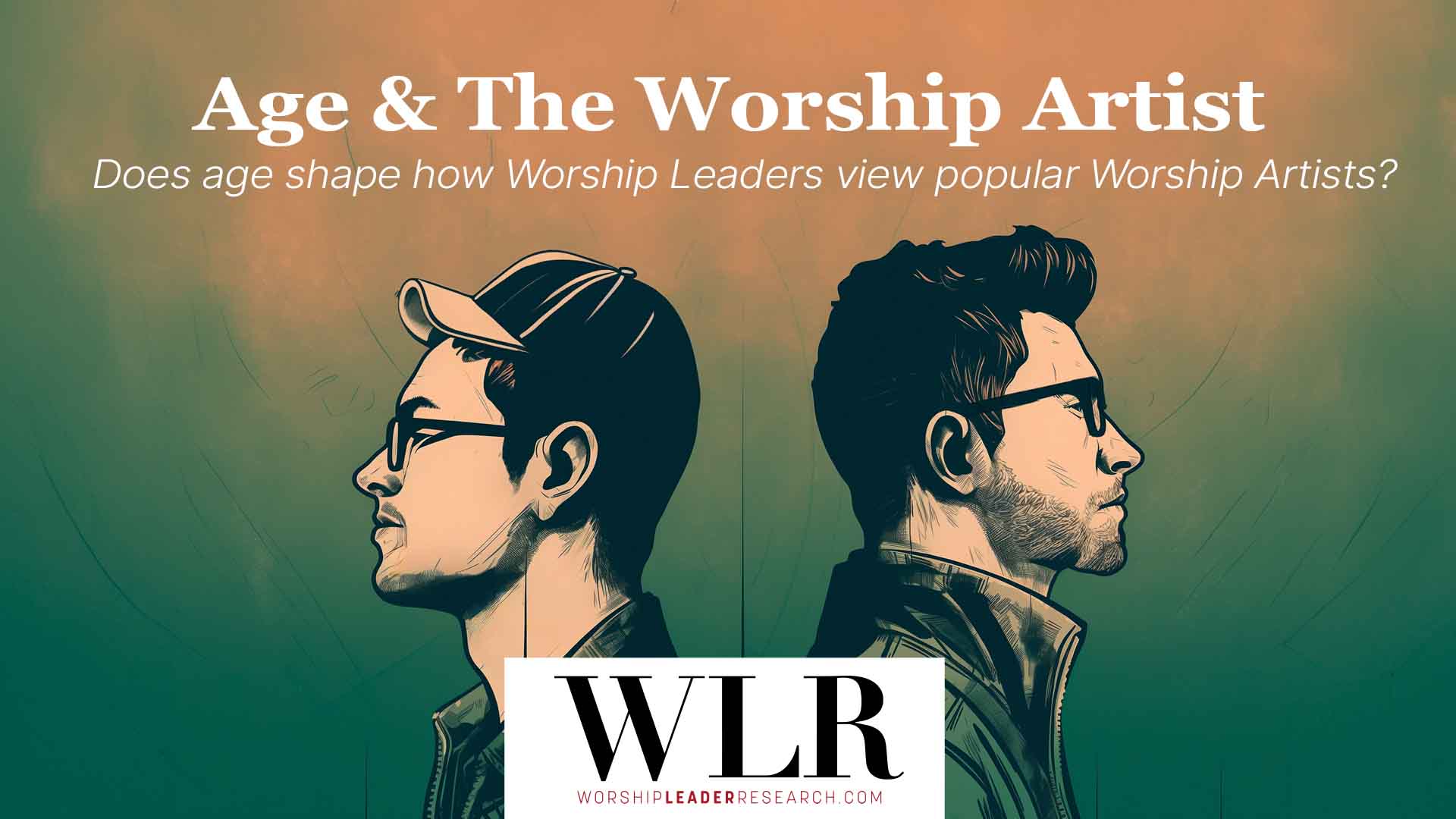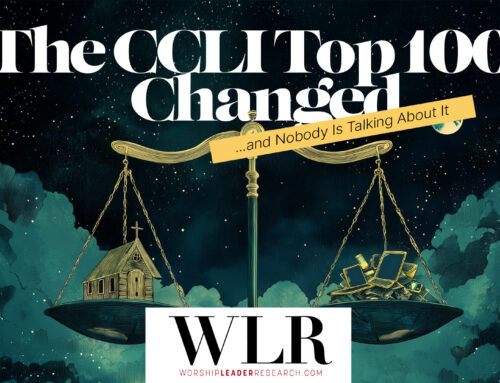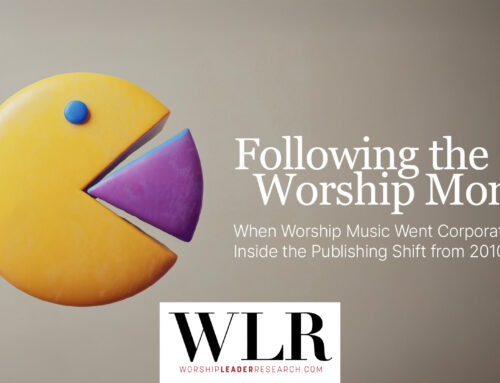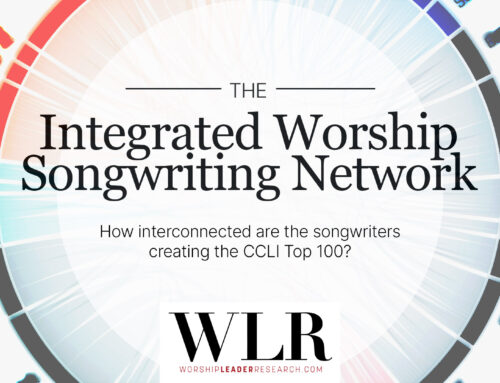When worship leaders talk about age, it’s mostly about the question of “aging out” and the hurt that has come from churches appearing to pass over older worship leaders in favor of their younger and more stylish counterparts. But “with age comes wisdom,” so the saying goes – does this saying extend to the way worship leaders navigate the worship music industry?
In our landmark survey of 412 worship leaders, 198 respondents were between the ages of 18 and 34, while 214 respondents were 35+ years old. Splitting the data this way divides the responses into two roughly equal demographic groups. Admittedly, these age categories don’t map neatly onto the current age brackets of Gen-Z, Millennial, Gen-X, etc., as the 25-34 age group cuts off between younger and older millennials. Nevertheless, creating these two large demographic groups creates some meaningful distinctions in the data across the survey.
In this article, we address how the age of worship leaders impacts the way they navigate song-artist associations, following from questions 2 and 3 of the survey. The first question provides the opportunity to explore how each group rationalized their disposition toward song-artist association, while the second question provides insights through a granular look at data across multiple song-artist associations.
General Song-Artist Associations
For a more industry-focused assessment of this question, see our previous article.
When asked about the importance of a song’s association with an artist, younger worship leaders (18–34) care more about who the artist is than older worship leaders (35+). As we’ve explored elsewhere, when the artist was considered important, respondents indicated that it was primarily because they want to avoid questionable theologies or practices associated with certain church groups. Almost no comments from either demographic group indicated that they chose songs by popular artists simply because the songs are popular. There are a few ways this might be interpreted. Perhaps the influence of sheer popularity is understood to be so commonplace that it requires no comment. Another possibility is that they interpreted the question slightly differently.
Though we did not include this in the actual phrasing of the question, comments by many respondents juxtaposed artist association with song content. Curiously, nearly one-third of comments from both age groups who indicated an “important” response focused on the priority of biblical lyrics. One would expect WLs who find lyrics or content the primary concern to respond with an “unimportant” response – and comments from those who responded also highlighted the importance of evaluating a song for its content, as expected.
A few other elements are notable from the survey comments that show similar attitudes across demographics. First, when the song’s association with an artist was seen as important it was, by far, because the respondent had negative associations with the artists. Second, very few spoke of the positive impact of a song’s association with an artist on their choice to use the song in gathered worship. One respondent explained, “It only works one way: a song that is associated positively with a ‘good’ artist isn’t enough to get it included in a service, but a song associated negatively with a ‘questionable’ church will disqualify it (even if has other merits).”
A very small number of respondents interpreted the question to be about the significance of artist popularity among congregants. One commenter noted that they considered the notoriety of a song-artist association in their pastoral responsibility to choose some songs that the congregation is likely to have encountered outside of church and is thus familiarized with and ready to engage the song for worship.
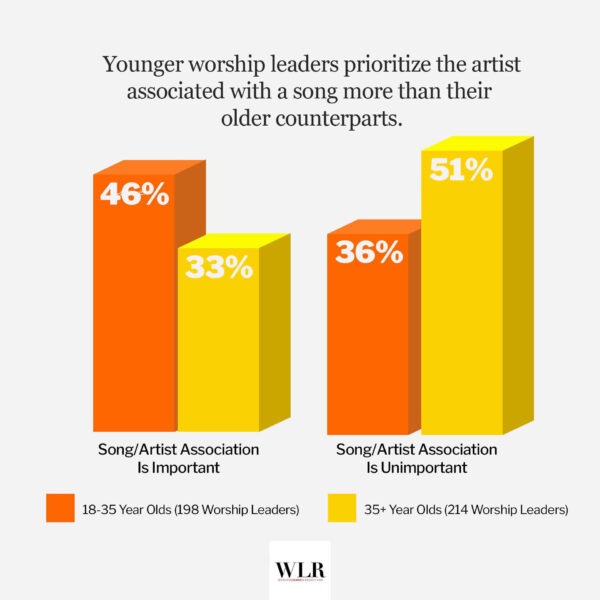 Despite the similarities in their comments, 46% of WLs who gave an “important” response were in the 18-34 year old group, versus just 33% of 35+. For those who gave an “unimportant” response, the numbers are flipped: 36% of WLs 18–34 vs 51% of WLs 35+.
Despite the similarities in their comments, 46% of WLs who gave an “important” response were in the 18-34 year old group, versus just 33% of 35+. For those who gave an “unimportant” response, the numbers are flipped: 36% of WLs 18–34 vs 51% of WLs 35+.
Overall, a song’s association with an artist is more important for younger worship leaders (18–34) than it is for older worship leaders (35+) by a noticeable margin.
Specific Song-Artist Associations
The survey asked: “How likely would you say you are to select a song for congregational use that is associated with…” (Bethel, Cody Carnes and Kari Jobe, Elevation, Hillsong, Jesus Culture, Passion, Phil Wickham, and Vertical Worship). Let’s first look at the survey response as a whole before going into the demographic breakdown. The largest segment of responses from worship leaders in both age demographics show 50% or higher “somewhat likely” and “very likely” average survey results for 7 out of 9 options. Bethel and Jesus Culture did not meet that average and likewise received the most “somewhat unlikely” and “very unlikely” responses, each with over 25%. The two church brands/artists that have existed the longest (Hillsong and Passion) received the combined highest “likely” responses than all the others, except for Phil Wickham who is favored across ages, above 70% combined likely responses.
Breaking down the data by demographic groups, we begin to see the difference in attitudes in general and toward specific artists.
UNLIKELY:
Perhaps surprisingly, Bethel had the highest “unlikely” responses among 18–34 yr olds (25.75%). Older worship leaders showed similar percentages of “unlikely” responses to their younger peers regarding Bethel and it was matched with their attitudes toward Jesus Culture (about 28% each). Passion (10%), Wickham (7%), Hillsong (12.5%) and Cody Carnes and Kari Jobe (12.5%) all scored very low on “unlikely” responses for 18–34 year olds. While the double-negative here may be confusing, it shows that younger worship leaders don’t feel negatively toward these groups–remember that we offer the “neither likely nor unlikely” option and so we must look to the other categories of response to see where their attitudes actually lay toward these artists.
LIKELY:
Phil Wickham, Hillsong, and Passion were the top three most “likely” responses among both demographic groups. Wickham was highest in both groups, with Hillsong in second for the 18–34 group and Passion in second for 35+. Younger and older WLs had the greatest gaps in their “likely” responses for Elevation, Hillsong, and Phil Wickham. For Elevation, 18–34 year olds responded “likely” at 64% and 35+ at 47% (17-point gap). For Hillsong, 18–34 year olds responded “likely” at 71% and 35+ at 53% (18-point gap). For Wickham, 18-34 year olds responded “likely” at a whopping 81% (the largest percentage response for any option) and 35+ at only 61.5% (19.5-point gap). Notably, older worship leaders still rated Phil Wickham the highest of all artists, despite being markedly lower than the score for 18–34 year olds.
NEITHER:
Nearly a third of 18–34 year olds responded “neither likely nor unlikely” to Cody Carnes and Kari Jobe and Vertical Worship. For WLs 35+, 7 out of the 8 options scored near 30% “neither likely nor unlikely” (Wickham scored lowest at 23%). Overall, WLs 35+ showed a higher level of indifference (+7%) on average toward all surveyed options than their younger peers.
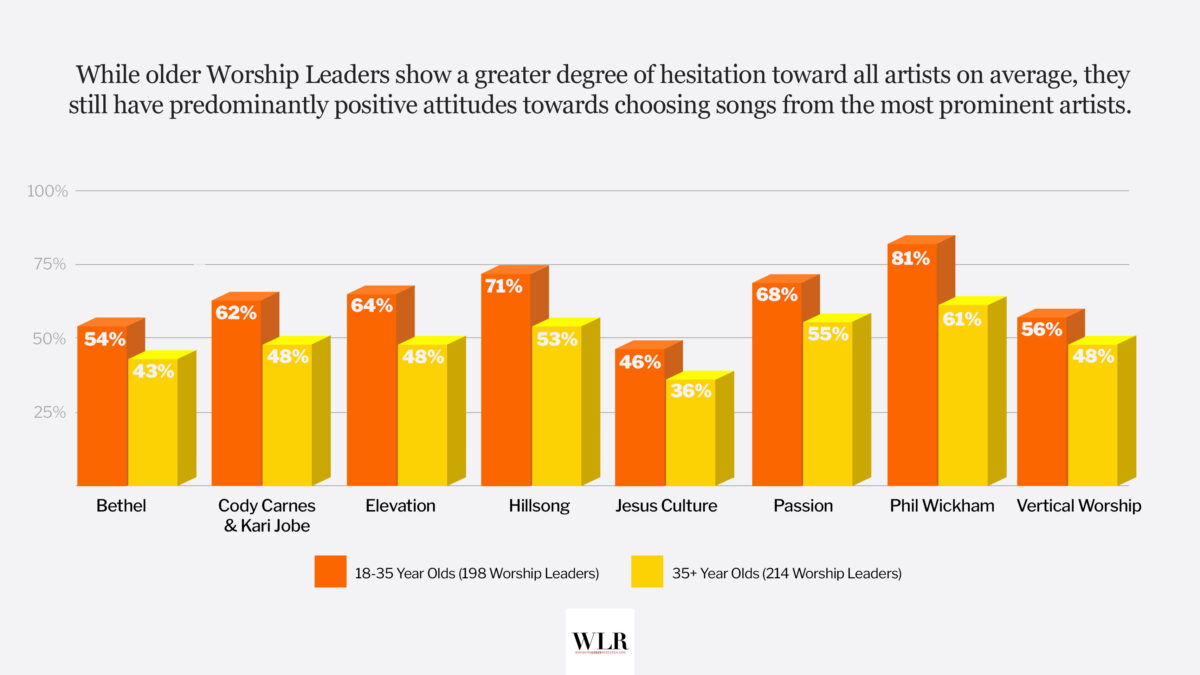
To these questions, WLs who are 18–34 average fewer “unlikely” (15% vs 20%) and “neither likely nor unlikely” responses (22% vs 29%) than their older peers, while averaging more “likely” responses (62.5% vs 48.7%). Interestingly, each artist/group received a larger number of “likely” responses from younger worship leaders than their older peers; worship leaders in the 35+ demographic responded “likely” at a lower rate for every option surveyed. Given that this is a survey of artists/groups with the most songs on our Top 25 aggregated list, it is perhaps unsurprising that all artists received the largest number of responses on the “likely” side.
Some Conclusions
What does this tell us about how age impacts the work of WLs as they navigate song associations with the artists in general and individual brands? First, it suggests that younger worship leaders navigate this element of the worship music industry with a greater degree of positivity and trust in song sources than their older peers. A song’s association with an artist is more important and more positive for WLs in the 18–34 range. While their older peers show a greater degree of hesitation toward all artists on average, they still have predominantly positive attitudes towards choosing songs from the most prominent artists. It is clear from survey comments that a few WLs begrudgingly choose songs related to popular artists, but the majority seem comfortable navigating any tension they feel between the songs content and the artist association.
What about younger leaders makes them feel more positively toward worship artists/churches? While the comments do not clearly reveal the reasoning for this deficit, the heightened awareness of celebrity worship leader culture and brand identity for worship artists may have a greater impact on younger worship leaders. This is especially relevant on the types of multimedia-heavy internet platforms favored by younger persons (YouTube and Instagram). Recently, Emily Snider Andrews has argued that worship lifestyle branding from the Big Four has had a more all-encompassing effect on the spirituality of younger Christians. This may also be a contributing factor in the positive associations among younger worship leaders regarding songs from particular artists.
Worship leaders and ministry coaches have acknowledged for, well, decades the concern regarding the age of WLs as churches try to attract and retain younger members. Across all markers of identity, folks are affirmed when they see someone like them (age, gender, race/ethnicity, etc) on the platform. Incorporating young people in leadership is the best way of connecting with other young people and their worship preferences as churches seek to create and sustain intergenerational communities. So to say, the church needs what younger worship leaders bring to the table.
One challenge for some WLs is keeping up with the most current popular songs while also providing the pastoral wisdom that comes with age. Our findings here don’t provide a silver bullet for addressing age, but they help clarify what might actually be going on between the age demographics of worship leaders. Older WL’s responses show a greater degree of hesitation with using songs by the most popular artists. Perhaps because they aren’t immersed in the social media culture of younger WLs, but also perhaps because they have grown in their discernment of what is good for the flock– a flock that is made up of folks that are, on average, also trending upward in age.
